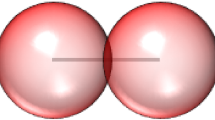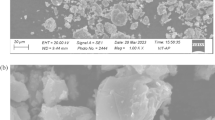Abstract
We present a 2D DEM-based model with bonded particles to simulate the uniaxial loading of a porous material. In this paper, we focus on the numerical study of the model parameters at the microscale (normal and tangential stiffnesses of the bonds, bond length, and friction coefficient) influence on the Young modulus and compressive strength of the modeled material. Young’s modulus exhibits linear dependence on the normal stiffness, whereas its dependence on the other parameters is more complex and hard to characterize. We illustrate that compressive strength depends linearly on the normal and tangential stiffness as well as on the bond length but it relates quadratically to the friction coefficient. Additionally, we illustrate that the model is scalable and that Young’s modulus and compressive strength do not depend on the particle size. The provided study allows the construction DEM-based model of porous material with prescribed properties to perform a simulation of uniaxial and triaxial loading of complex heterogeneous materials.











Similar content being viewed by others
References
Abdelhamid Y, Shamy UE (2016) Pore-scale modeling of fine-particle migration in granular filters. Int J Geomech 16(3):04015086
Alassi HT, Holt R (2012) Relating discrete element method parameters to rock properties using classical and micropolar elasticity theories. Int J Numer Anal Methods Geomech 36(10):1350–1367
Alkhimenkov Y, Caspari E, Gurevich B, Barbosa ND, Glubokovskikh S, Hunziker J, Quintal B (2020) Frequency-dependent attenuation and dispersion caused by squirt flow: three-dimensional numerical study. Geophysics 85(3):MR129–MR145
Banerjee A, Pasupuleti S, Mondal K, Nezhad MM (2021) Application of data driven machine learning approach for modelling of non-linear filtration through granular porous media. Int J Heat Mass Transf 179:121650
Bao J, Zhang Y, Wu H, Zhou Y, Yue Z (2022) Sintering characteristics, crystal structure and dielectric properties of cobalt-tungsten doped molybdate-based ceramics at microwave frequency. J Materiomics 8(5):949–957
Bazaikin YV, Malkovich EG, Derevschikov VS, Lysikov AI, Okunev AG (2016) Evolution of sorptive and textural properties of CaO-based sorbents during repetitive sorption/regeneration cycles. Chem Eng Sci 152:709–716
Caspari E, Novikov M, Lisitsa V, Barbosa ND, Quintal B, Rubino JG, Holliger K (2019) Attenuation mechanisms in fractured fluid-saturated porous rocks: a numerical modelling study. Geophys Prospect 67(4):935–955
Cundall PA, Strack ODL (1979) A discrete numerical model for granular assemblies. Géotechnique 29(1):47–65
Derevschikov VS, Kazakova ED, Yatsenko DA, Veselovskaya JV (2021) Multiscale study of carbon dioxide chemisorption in the plug flow adsorber of the anesthesia machine. Sep Sci Technol 56(3):485–497
Derevshchikov VS, Kazakova ED (2020) Comparative analysis of the chemical composition and sorption, textural, and strength properties of commercial medical co2 sorbents. Catal Ind 12(1):1–6
Feng GS, Wu SI, Han HI, Ma LW, Jiang WZ, Liu XQ (2011) Sintering characteristics of fluxes and their structure optimization. Int J Miner Metall Mater 18(3):270
Gibou F, Fedkiw R, Osher S (2018) A review of level-set methods and some recent applications. J Comput Phys 353:82–109
Hardy S, Finch E (2005) Discrete-element modelling of detachment folding. Basin Res 17(4):507–520
Hardy S, McClayc K, Munozb JA (2009) Deformation and fault activity in space and time in high-resolution numerical models of doubly vergent thrust wedges. Mar Pet Geol 26:232–248
Hazzard JF, Young RP (2000) Simulating acoustic emissions in bonded-particle models of rock. Int J Rock Mech Min Sci 37(5):867–872
Khachkova T, Lisitsa V, Kolyukhin D, Reshetova G (2021) Influence of interfaces roughness on elastic properties of layered media. Probab Eng Mech 66:103170
Lisitsa V, Kolyukhin D, Tcheverda V, Volianskaia V, Priimenko V (2019) GPU-based discrete element modeling of geological faults. In: Voevodin V, Sobolev S (eds) Supercomputing. Springer, Berlin, pp 225–236
Mavko G, Mukerji T, Dvorkin J (2009) The rock physics handbook. Cmabridge University Press, New York
Osher S, Fedkiw RP (2001) Level set methods: an overview and some recent results. J Comput Phys 169(2):463–502
Peirce A, Detournay E (2008) An implicit level set method for modeling hydraulically driven fractures. Comput Methods Appl Mech Eng 197(33):2858–2885
Potyondy DO, Cundall PA (2004) A bonded-particle model for rock. Int J Rock Mech Min Sci 41(8):1329–1364
Prokhorov D, Lisitsa V, Khachkova T, Bazaikin Y, Yang Y (2022) Topology-based characterization of chemically-induced pore space changes using reduction of 3d digital images. J Comput Sci 58:101550
Quintal B, Steeb H, Frehner M, Schmalholz SM (2011) Quasi-static finite-element modeling of seismic attenuation and dispersion due to wave-induced fluid flow in poroelastic media. J Geophys Res 116:B01201
Rahimpour MR, Jafari M, Iranshahi D (2013) Progress in catalytic naphtha reforming process: a review. Appl Energy 109:79–93
Shulakova V, Pervukhina M, Muller TM, Lebedev M, Mayo S, Schmid S, Golodoniuc P, Paula OBD, Clennell MB, Gurevich B (2013) Computational elastic up-scaling of sandstone on the basis of x-ray micro-tomographic images. Geophys Prospect 61(2):287–301
Solovyev S, Novikov M, Lisitsa V (2023) A numerical investigation of wave-induced fluid flows in anisotropic fractured porous media. Comput Math Appl 140:78–88. https://doi.org/10.1016/j.camwa.2023.03.013
Tavelli M, Chiocchetti S, Romenski E, Gabriel AA, Dumbser M (2020) Space-time adaptive ADER discontinuous Galerkin schemes for nonlinear hyperelasticity with material failure. J Comput Phys 422:109758
Vesga LF, Vallejo LE, Lobo-Guerrero S (2008) Dem analysis of the crack propagation in brittle clays under uniaxial compression tests. Int J Numer Anal Methods Geomech 32(11):1405–1415
Wessling A, Larsson S, Jonsen P, Kajberg J (2022) A statistical dem approach for modelling heterogeneous brittle materials. Comput Particle Mech 9(4):615–631
Yan Z, Wilkinson SK, Stitt EH, Marigo M (2015) Discrete element modelling (dem) input parameters: understanding their impact on model predictions using statistical analysis. Comput Particle Mech 2(3):283–299
Yazykov NA, Dubinin YV, Simonov AD, Reshetnikov SI, Yakovlev VA (2016) Features of sulfur oils catalytic combustion in fluidized bed. Chem Eng J 283:649–655
Zhang W, Dai G, Wang F, Sun S, Bassir H (2007) Using strain energy-based prediction of effective elastic properties in topology optimization of material microstructures. Acta Mech Sin 23(1):77–89
Zhao H, Liu C, Zhang J, Ge L (2021) Breakage behavior of gravel rock particles under impact force. Comput Particle Mech 8(5):1075–1087
Zhou YC, Xu BH, Yu AB, Zulli P (2002) An experimental and numerical study of the angle of repose of coarse spheres. Powder Technol 125(1):45–54
Acknowledgements
The research was supported by the Mathematical Center in Akademgorodok, the agreement with the Ministry of Science and High Education of the Russian Federation number 075-15-2022-281 dated 05.04.2022.
Author information
Authors and Affiliations
Corresponding author
Ethics declarations
Conflict of interest
On behalf of all authors, the corresponding author states that there is no conflict of interest.
Additional information
Publisher's Note
Springer Nature remains neutral with regard to jurisdictional claims in published maps and institutional affiliations.
Rights and permissions
Springer Nature or its licensor (e.g. a society or other partner) holds exclusive rights to this article under a publishing agreement with the author(s) or other rightsholder(s); author self-archiving of the accepted manuscript version of this article is solely governed by the terms of such publishing agreement and applicable law.
About this article
Cite this article
Chepelenkova, V., Lisitsa, V. Effect of DEM inter-particle parameters on uniaxial loading modeling results. Comp. Part. Mech. 10, 2021–2030 (2023). https://doi.org/10.1007/s40571-023-00604-y
Received:
Revised:
Accepted:
Published:
Issue Date:
DOI: https://doi.org/10.1007/s40571-023-00604-y




